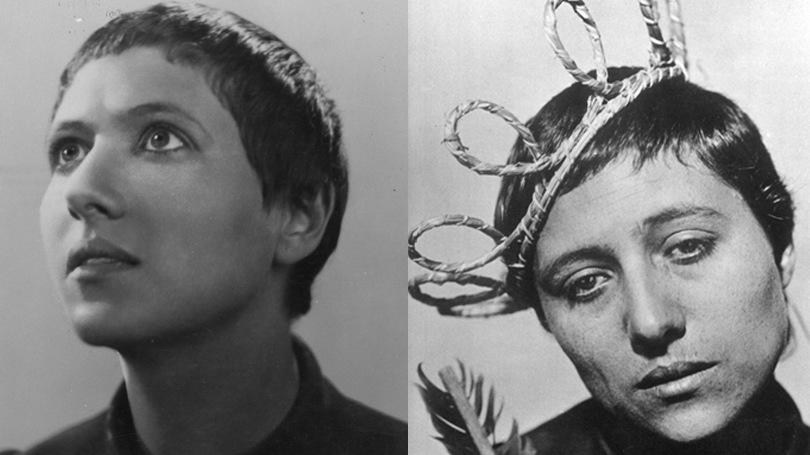French actress of Corsican-Italian ancestry, born in Pantin outside Paris, 21 July 1892 – 12 December 1946.
Growing up poor, Falconetti was schooled by nuns who did not much encourage her acting ambitions. Her fortunes improved when she met a much older factory owner whose secretary she became.
Against all odds, Falconetti was admitted to the Conservatory, where she trained under the tutelage of Eugene Sylvain, who years later would play the grand inquisitor in The Passion of Joan of Arc.
During World War I, Falconetti entertained the French troops and started getting small parts on stage. She became established in the early 1920s, mainly playing "Boulevard roles" (light comedies) but also performing some classic repertoire and doing a fair bit of singing, which she appears to have enjoyed more than acting. She also modelled for advertising.
In the mid-1920s, she was admitted to the prestigious Comédie Française, but soon dropped out on her own volition to return to the Boulevard and take control of her career.
Dreyer discovered Falconetti while she was performing La Garçonne, a scandalous play about a freethinking feminist. During a private interview in Falconetti’s flat on the Champs Elysées, Dreyer scrutinised her face without makeup and realised he can use her in the groundbreaking way he had in mind for his portrait of Joan of Arc.
During nine months of filming with Dreyer, Falconetti endured some very tough and demanding work conditions but poured everything she had into her performance. To get the highest degree of dramatic intensity from his leading lady, Dreyer shot the film in sequence and did her close-ups in private, sheltered by screens. When the shooting day was over, they would stay through the night to watch the rushes and discuss possible changes to improve her performance the next day.
Falconetti would arrive at the studio in a luxurious, white, chauffeured limousine, in fancy clothes and costly jewellery, but was transformed the moment she got into costume. The emotional highlight of the shoot was the scene that required her to cut her hair, something she had agreed to in her contract. Many technicians are said to have cried with her during that scene.
When the film was finished, a new collaboration between Falconetti and Dreyer was announced: Catacombes (according to Martin Drouzy in "Les années noire de Dreyer"), but the film was never realised. In fact, Falconetti never acted in another film.
In 1929, Falconetti was at the peak of her career. She acquired her own theatre, though it quickly went bankrupt because of mismanagement. When her millionaire benefactor passed away, she became increasing unstable and unreliable in her professional life, although she still maintained the favour of the Boulevard audiences. In the early 1930s the public spoke more of her extravagances than her performances. She played Joan of Arc on stage in a piece by Saint-Georges de Bouhélier, Jeanne d'Arc, la Pucelle de France(premiering 21 November 1934 at the Théâtre de l'Odéon, Paris). According to her daughter, Falconetti used parts of her wardrobe from Dreyer’s film. In 1935 she was singing in a cabaret under a pseudonym and acting in a play with Louis Jouvet. It was the last time she acted in France.
Falconetti left France and spent a few years in Italy and Switzerland. Although she was almost broke, she maintained a frivolous lifestyle. She would plan unrealistic enterprises and dream of glorious comebacks. As her financial situation deteriorated, she was planning to go to America, but she could find no one to sponsor her visa.
Eventually, she headed to South America, in 1942. After spending a year in Rio, she arrived in Buenos Aires in 1943. By now she had lost what remained of her fortune, presumably from horse-track gambling. Though Buenos Aires was full of expatriate French actors, she only managed to form a small company of amateurs, which performed four plays at a small, insignificant theatre. To make ends meet, she gave elocution classes to young French-Argentines.
All the while, she was a popular figure in the city’s French circles. People remember her reciting poems and singing songs in an extraordinary manner. On the French Liberation Day, July 14, she gave an unforgettable rendition of La Marseillaise on stage.
As the years passed, her activity slowed. Even while she was struggling to provide for herself, she allegedly turned down a film part and other comeback opportunities, as she became increasingly obsessed with mystical beliefs.
Falconetti passed away on 12 December 1946 under mysterious circumstances. Some sources mention an attack brought on by a harsh dietary regimen; others say she died from indigestion after a copious meal. Her remains were entombed in an Argentine cemetery until 1960, when they were cremated. Her ashes now rest in the Montmartre Cemetery in Paris.
By Mirko Stopar | 04. June
